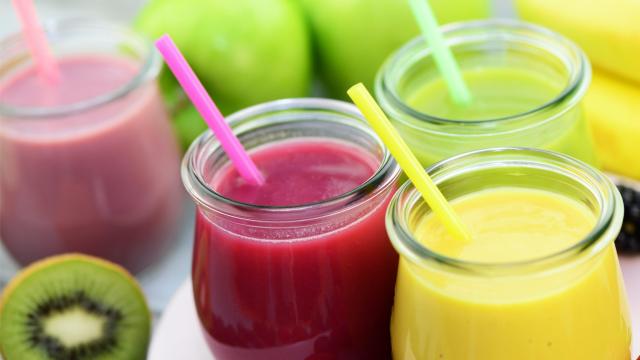Cold pressed juices have a healthier reputation than just throwing a few fruits and veggies in a blender. They’re expensive, they need to be eaten fresh, and juice sellers and devotees sing the praises of their supposed health benefits. But how different is a juice from a smoothie, really?
What’s the difference between a juice and a smoothie?
A smoothie is made in a blender. The blades cut the fruits, vegetables, or other ingredients into tiny pieces, and mix those tiny pieces with liquid (both the juice that is released from the fruit, plus any liquid such as milk or water that was added in the recipe).
A juice, by contrast, is only the liquid portion of the fruit or vegetable. While you can juice an orange or a lemon by simply squeezing or reaming it, juicing machines typically grind or mash the fruit (much like a blender) and then separate the juice from the solids. You drink the juice, and throw out the pulp.
How do juices and smoothies differ, nutritionally?
Smoothies contain everything that was in the fruit or vegetable to start with. Nutritionally, drinking a smoothie is equivalent to eating all of its ingredients. I could make myself a bowl of yogurt with honey and berries, or I could throw yogurt and honey and berries into a blender with a bit of water to allow it to be liquid.
The nutritional value of a smoothie depends on what you add in. If you’ve got fruit and you’re adding juice and you’re also adding a sweetener like honey, you can wind up with something that’s high calorie and full of sugar.
Juices, by contrast, remove the fibre from fruits and vegetables (the pulp you throw out is mainly fibre), which is unfortunate because fibre is an important nutrient most of us should get more of. There are plenty of vitamins and phytonutrients in the juice, but the fruit would have contained those, too. The juice also ends up being a more concentrated source of sugar than the original fruit, and may be less filling.
If you’re choosing from a nutritional standpoint, and you’re comparing a smoothie and a juice with similar ingredients, the smoothie is almost always going to be the healthier option.
People who are into juicing will talk up the benefits of vitamins, antioxidants, and other components of the fruit. (Fresh fruits and smoothies have these, too.) They’ll argue that cold-pressed juices have more of these nutrients than store-bought juice. (Even if true, you could just eat the fruit or make your own smoothie to get the benefits.) Sometimes they’ll claim that juices detox you, or help your body detox itself. (Bullshit.)
Juices are a perfectly ok thing to drink if they make you happy, but none of their supposed benefits amount to an advantage over eating whole fruit or even blending yourself a smoothie.
Why are people so into juicing?
I’m convinced that juicing’s cachet is solely because it’s more expensive to make a juice than to throw together a smoothie.
Juicing got its start as a health food trend when Californians started selling juice to gym-goers, inspired by a man who had no medical credentials but who wrote multiple books making impossible but enticing claims about what juicing can do for health. (Among their titles: Become Younger and Water Can Undermine Your Health.)
Juicers are substantially more expensive than blenders, and juicing devotees will tell you that the cheap juicers just aren’t good enough; they supposedly destroy the juice’s micronutrients. Similar arguments are made against store-bought juices, pasteurised juices, and any juice that’s not made fresh immediately before you drink it.
In other words, the attraction of juicing isn’t that it has unique health benefits; it’s that fancy juices are difficult and expensive to acquire, making you special if you are a person who can drink them regularly. (They also look colourful and enticing on Instagram or TikTok, which can’t hurt.) If you’re actually interested in the health benefits of the vitamins and micronutrients found in fruit, the best way to get them is by simply eating the fruit. And if you want to drink them, a smoothie will do just fine.

Leave a Reply
You must be logged in to post a comment.